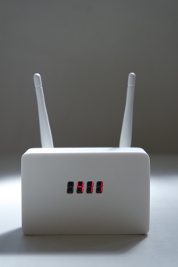The project page can be found here.
Did you find this script useful? Feel free to support my open source software:
Most mobile devices — such as smartphones — are always searching for wifi networks they have been connected to in the past. Your phone is basically yelling every name of every network it has ever been connected to — at home, at the office or at that hotel with the dodgy connection — to see if it will get a response from the router. These messages contain enough unique information* to be used to fingerprint and track individuals, something that is already being done by many different parties, and for various reasons. Shops for instance, use this data to track how many people walk by, how many actually come into the store, and how much time you’ve spent in the candy aisle before making your choice.
Linger is a small, portable device that allows you to create and blend into a virtual crowd by storing the specific wifi signals from everyone that comes near you, and rebroadcasting their signals infinitely when they leave, making it seem as if they are still there. As you pass people in the street and their signals are stored in the database, a small display on the device automatically updates to show the number of unique individuals in your group.
Physically they may have left, but their virtual presence will stay with you forever.
* This information can be faked (like Linger is doing) and some software even allows you to turn these signals off completely, but most devices will send these signals by default (including iPhones and most Android devices).
Linger listens for and stores probe requests coming from WIFI enabled devices within range into an sqlite database. When these devices leave the area (determined by the time since their last probe request) it will start resending the saved probe requests (with updated sequence numbers), tricking other listeners into thinking the device is still there.
Most WIFI enabled devices remember the names of all wireless networks they have been connected to in the past. Whenever your device is on, but not connected to a network (or sometimes even when connected), it will broadcast the names of these known networks (so called probe requests). In theory, when a router notices a device calling out its name, it will respond by saying it's there and a connection will be set up.
In practice, this broadcasting of networks names is not needed. Routers often broadcast their own presence anyway (you know, that list of network names you can select from when you turn on your wifi). So instead of asking for known networks, your device can also wait and listen to find out if a known router is nearby.
The problem with actively sending out probe request is that those messages contain a 'unique' device number and the name of the network your device wants to connect to. This can act as a fingerprint to your device, and by using one of many geolocation databases with network names, it is trivial to find out where a device (and so, its user) has been before (think of names like "The Hague Airport", or "some company name") - a tactic used by shops and other commercial parties to track people.
Linger listens for, and saves, probe requests coming from all WIFI enabled devices that are within reach. When these devices leave the area (determined by the time since their last probe request) it will start resending the saved probe requests, tricking others that might be listening into thinking the other device is still there.
The more devices linger sees, the larger its collection of saved probe requests will become. This way, a virtual crowd of people will linger and grow around the device.
The device uses a 7-segment LED display, a Raspberry Pi Zero, two TL-WN722N Wifi dongles and a powered USB hub. The powered hub is needed because the Pi can't provide enough power to run both Wifi dongles.
A simple explaination of how to connect the 7-segment display and some example code can be found here. After I checked eveything was working, I stripped the cases off of the Wifi dongles and USB hub, removed the USB sockets from the PCBs and connected all of the different parts by small wires to save space. I've put some cardboard inbetween the different components to prevent any shorts.
I've also soldered in a single full-size female USB A port; I used this to connect a USB-to-ethernet adapter for easy access to the Pi. A small momentary switch was also added to power off the device. I used the first scematic on this page.
There are three parts to this script:
linger_rx: receives probe requests and saves them toprobes.sqliteby defaultlinger_tx: transmits probe requests found in the databaselinger_counter: gets the amount of unique MAC addresses in the database and shows this on a 7-segment display.
Copy the three .sh files to /etc/init.d/. Make sure they are executable
(chmod +x linger_*). Then register them so they are started after booting
by running sudo update-rc.d <filename> defaults for each of the three files.
To power down the device I used the circuit and code found here). After pressing my power button the display turns off to show the shutdown script is running, and after about 10 seconds it is safe to remove the power cable.
- To create the startup scripts I used a tutorial by Stephen C Phillips.
- The script to control a tm1637 7-segment display from Python is a modified version of a script by Richard IJzermans.
- The schematic and code for the power button come from Raspberry Pi Geek.


